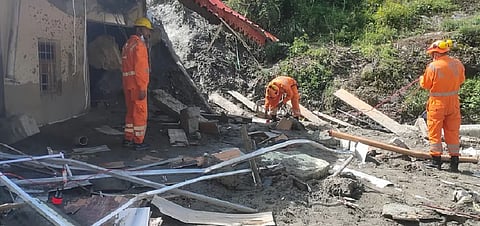The Chashoti and Dharali disasters serve as critical reminders that not all high-mountain floods are GLOFs
In August 2025, two similar geomorphic disasters struck different sectors of the Indian Himalaya, reflecting the fragile and dynamic nature of the region. On August 14, the Chashoti area of Paddar in the Western Himalaya (Kashmir) was hit by a catastrophic debris flow, initially suspected to be a Glacial Lake Outburst Flood (GLOF). Detailed assessments using Sentinel-2A imagery, field observations, and eyewitness accounts later confirmed that intense rainfall, rather than a lake breach, was the primary trigger. Just days earlier, on August 5, a comparable event unfolded in the Central Himalaya (Uttarkashi district, Uttarakhand), where Dharali and Harsil villages experienced a debris-laden flash flood, also first misclassified as a GLOF but ultimately attributed to extreme rainfall. These two events, occurring in the Western and Central Himalaya within the same month, provide valuable case studies for understanding the increasing role of rainfall in driving debris flows and the need for accurate hazard characterisation.
The Chashoti event: A rainfall-induced debris flow
Pre- and post-event satellite images revealed geomorphic changes were observed in the nala immediately below the glacier snout, where small channels rapidly widened and merged into a debris flow (see below) The trigger was an intense, short-duration (15-20 minutes) rainfall episode that generated sudden surface runoff. This runoff incised loose valley-floor sediments, destabilising unconsolidated debris. Multiple channels converged into a high-energy slurry of water, rocks, and sediments, accelerating down a steep 450-m descent within 1 km of Chashoti village. The resulting debris-laden flash flood resembling wet concrete in motion obliterated infrastructure and farmland. Geomorphic evidence strongly supports classification of the Chashoti disaster as a rainfall-triggered debris flow.
The Dharali event: A parallel case from Uttarakhand
A comparable event occurred on August 5, 2025, in the Central Himalaya, affecting Dharali and Harsil villages in Uttarkashi district, Uttarakhand. The disaster took the form of a debris-laden flash flood, triggered by intense rainfall over the peri-glacial catchment. Although some preliminary reports speculated a possible GLOF or hanging glacier detachment, there is no clear evidence to support these claims. Dharali, situated on an alluvial fan within the peri-glacial zone, was particularly vulnerable: the combination of short-duration, high-intensity rainfall, unstable slopes, and unconsolidated sediments amplified the debris flow, channeling it toward the village and surrounding farmland.
When compared with the Chashoti event in the Western Himalaya, the Dharali disaster reinforces a common theme: extreme rainfall can rapidly mobilise fragile slope materials and valley-floor sediments into destructive debris flows. Together, these two events emphasise the urgent need for refined hazard monitoring, improved classification protocols, and effective communication strategies to strengthen disaster preparedness in Himalayan communities.
The schematic diagram (Figure 3) effectively illustrates this chain: the glacier and its moraines form the base of a vulnerable landscape, while extreme rainfall acts as the immediate trigger, amplifying the hazard potential in these high-mountain environments. As Himalayan glaciers retreat due to rising temperatures and imbalanced snow accumulation, they expose terrain that was previously covered by ice. During their movement, glaciers transport rock and soil, depositing it as moraines, loose, unconsolidated debris along their edges, centre, or terminus. Occasionally, dead ice chunks remain buried within these moraines, and as they melt over time, they leave depressions and unstable sediment piles. These freshly exposed, fragile deposits are highly susceptible to collapse. In steep, narrow Himalayan valleys, intense rainfall or cloudburst events can mobilise this loose material, triggering landslides, rockfalls, and debris flows.
The permafrost factor: The hidden hazard in the Himalaya
Permafrost is a perennially frozen ground, widespread in the high-altitude glaciated terrains of the Himalaya, yet it remains one of the least studied components of the region’s cryosphere. Globally, permafrost thaw has been linked to catastrophic slope failures and debris flows, as extensively documented in Alaska, the Canadian Arctic, and the European Alps. In stark contrast, India lacks systematic records of permafrost-related hazards. This gap is not necessarily due to their absence, but rather to limited monitoring networks, scarce ground observations, and the invisibility of subsurface processes in conventional hazard assessments.
Permafrost degradation alters the mechanical stability of rock and sediment by releasing ground ice and weakening frozen slopes. In steep Himalayan valleys, this can amplify the likelihood of debris flows, landslides, and cascading hazards. The Chashoti and Dharali disasters highlight the urgent need to treat permafrost as a potential trigger in high-mountain hazard attribution. Without mapping permafrost distribution and monitoring its thermal dynamics, its role in slope instability will remain an overlooked but critical blind spot.
Policy gaps and the need for science governance integration
Currently, Indian cryosphere hazard management frameworks place strong emphasis on GLOFs especially after the Sikkim GLOF in 2023. However, these recent events highlight the equal importance of addressing rainfall-triggered debris flows and emerging permafrost-related risks. Together, they point to three urgent priorities.
Systematic data sharing: Scientific assessments must be rapidly communicated to disaster management authorities.
Risk-informed planning: Infrastructure design, road alignment, and settlement expansion in mountain regions should consider debris flow-prone catchments, unstable moraines, and potential permafrost zones.
National framework on cryosphere hazards: A dedicated policy integrating glacier, debris flow, and permafrost-related hazards is critical for bridging scientific knowledge and community resilience.
The Chashoti and Dharali disasters serve as critical reminders that not all high-mountain floods are GLOFs. Rainfall-triggered debris flows, amplified by unstable moraines and possibly thawing permafrost may represent more frequent and under-recognised threats to Himalayan communities. For effective disaster risk reduction, scientific insights must be mainstreamed into policy frameworks, ensuring that Himalayan settlements and infrastructure are developed with a nuanced understanding of their dynamic cryosphere and geomorphic environment.
Remya S N is Assistant Professor at the School of Climate Change and Sustainability, Azim Premji University, Bangalore. She is also CryoHub Member of ICIMOD, representing India
Views expressed are the author’s own and don’t necessarily reflect those of Down To Earth

